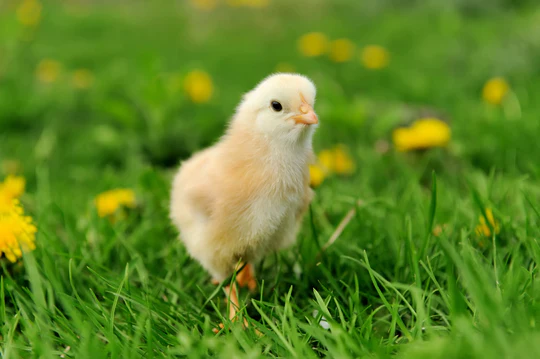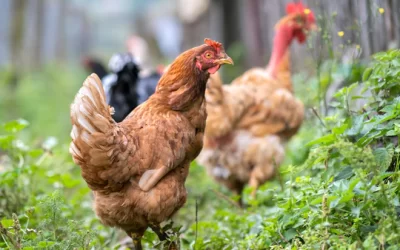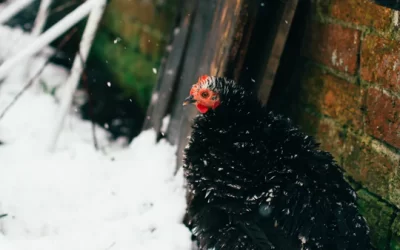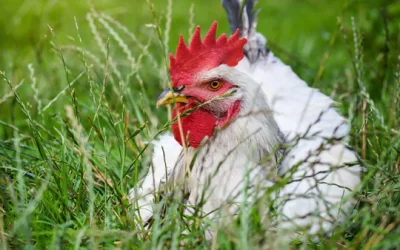Raising chicks takes lots of preparation and time. If you are ready to raise chicks of your own, follow these easy steps!
Be Prepared
Before you bring your chicks home, you will need to gather some supplies.
Brooder
A brooder is a chick’s transitional home – a warm, safe, contained space where they can be closely watched and cared for before they are big enough to enter a regular coop.
You can buy or make your own brooder. It should be at least 12 inches tall, draft-free, and provide at least 2 square feet of space per chick. Make sure you wash, disinfect, and dry your brooder before the chicks arrive.
Bedding
Chicks need a soft, comfy place to live. In the first week, their feet can sometimes have a hard time gripping. Because of this, it is not a good idea to use slippery materials, like newspapers.
After that, switch to a 4-6 inch deep layer of shavings. As their name implies, hardwood shavings are too tough for chicks. We recommend pinewood shavings or a hay/straw mix.
Waterer
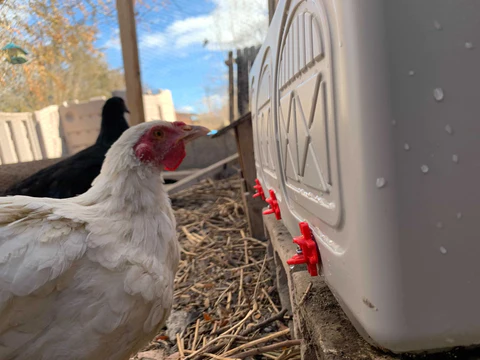 One of the most important things chicks need is a constant source of clean, fresh water. We recommend our OverEZ high-capacity waterer. The completely enclosed waterer keeps water clean and fresh, and the nipple drinking system keeps the brooder dry.
One of the most important things chicks need is a constant source of clean, fresh water. We recommend our OverEZ high-capacity waterer. The completely enclosed waterer keeps water clean and fresh, and the nipple drinking system keeps the brooder dry.
The Chicken Waterer holds 12 gallons of water and allows 3 chickens to drink at one time.
Light
Chickens need to be kept warm as they grow and develop their feathers. You will need a light to hang over the brooder to provide the warmth they need. As the chicks grow and need less heat, you can adjust the height of the lamp.
Feed
Chicks have different nutritional needs than adult chickens, so make sure to have a feed that is made specifically for them. Look for chick grower rations with protein, vitamins, and minerals. Generally, crumbles are easier for chicks to eat.
Grow Time
Heat Regulation
Chicks regulate their own heat to a certain point. They stand under the light if they are cold and move away if they are warm. They also huddle together to provide warmth for the group.
When chicks huddle together, they can cause accidental smothering or suffocation, so it is important to check on them regularly to make sure they are all safe.
As chicks grow, their need for heat diminishes, so you can raise the height of the light.
Here are some general temperature requirements:
- Day 0-7 (95°F)
- Day 7-14 (90°F)
- Day 14-21 (85°F)
- Day 21-28 (80°F)
- Day 28-35 (75°F)
- Day 35 (70°F)
Each time you raise the height of the light, observe the birds closely to make sure they are comfortable and safe.
Clean Water
Water is essential for healthy chicks. When you first introduce the chicks to the brooder, be sure to give them fresh water before you give them access to feed.
Check their water levels every day to make sure they are consuming enough. You may want to consider adding a water protector to their water supply to keep it fresh and free of residue and contaminants.
Bad Habits
Adolescent chickens are feisty and can behave badly. Keep a close eye on their interactions to protect against bullying and injuries.
Make sure the birds have enough space to reduce mischief. If they are too close together, toe picking or feather plucking might break out, and those are hard habits to break.
Feed
For the first few days, give your chicks easy access to their feed by sprinkling it directly on the brooder floor. After that, you can place a chick feeder into the brooder.
Just like the water, check the feed levels to make sure they are eating enough. To help their digestion, be sure to also offer grit in a separate feeder – they will need special chick grit until they are around 8 weeks old.
Where to Get Chicks?
Feed Stores
In the springtime, it is hard to miss the sounds of peeping in local ranch stores. Oftentimes, these stores will have “chick days” during the spring where they have special pricing on chicks and supplies.
Poultry Association
You can also find chicks through your local poultry association. These associations are full of great resources as you begin raising chickens. Additionally, you can join these associations, and take part in the competitions and shows when your chicks have grown.
Directly From Breeders
Or, skip the middleman and order chicks directly from breeders. The breeders will generally have two shipments of chicks during the spring and will mail a box of chicks directly to you. Be aware that these shipments will go directly to the post office for you to pick up, instead of being delivered to your home. Just like with human babies, the delivery date is approximate, so make sure you are ready a few days before the expected date.
Day 1 Of Raising Chicks
Preheat
Be sure to turn on the heat lamp before you bring your chicks home. Temperature is vital for chicks’ health, so if you wait to turn on the lamp until chicks arrive, the time it takes for the lamp to reach the right temperature could prove dangerous, if not fatal to the chicks.
Reduce Stress
The general rule for day one is to look, but don’t touch. Chicks are prone to stress, especially during travel, so give them some touch-free time after you place the chicks in their brooder. Do keep an eye on them though to make sure they are finding water and food, and that they do not seem dazed, lethargic, or cold.
Hydrate
Water is essential for chicks. Make sure water is available to them as soon as they enter the brooder. Hold off on introducing feed for a few hours to really make sure they hydrate.
If you are getting chicks directly from a breeder, as you place each chick directly into the brooder, firmly hold their beaks down in the waterer until they take a gulp of water, this teaches them how to drink in the future.
It is also helpful to initially give the chicks warm water, this will help them maintain their temperature. Cold water could drop their internal temperature dangerously low.
Week 1 of Raising Chicks
Crowding
Keep an eye on your chicks to make sure they are happy and have enough space. Corners can be especially tricky for the chicks, with the chance of getting stuck, trampled, or suffocated. You may want to use some scrap pieces of cardboard to block the brooder corners. This will make a nice rounded space for the chicks.
Temperature
For the first week, make sure you maintain a temperature of at least 95 degrees in the brooder. Hang the heat lamp on one side of the brooder so the chicks can self-regulate. They can stand directly under the lamp if they are cold, or stand to the side in the cooler area if they are too hot. If you notice the chicks constantly crowding together under the lamp, they may be too cold. Chicks will crowd to help warm each other up.
Feeding
Make sure you are giving the chicks feed that is formulated especially for chicks. A chick layer feed will have all the nutrition they need. Check regularly on their feed to make sure it has not run out. Chicks will not overeat, so you can fill their feeder without worry.
Clean Bedding
Chicks are messy! They will get their food and droppings everywhere, including in their feeder and waterer, so change out their bedding often to keep it clean and dry.
Pasty Butt
One sign of stress in chicks is called pasty butt, for literal reasons. Their feces will get stuck down their anus and “paste-up” their means of defecations. If they are left plugged up, it can be fatal.
At least daily, hold each chick upside down and check for blockage. You can clean a blockage with a wet washcloth, or rip the dried paste off, like a band-aid. A little apple cider vinegar in their water can help prevent the blockage.
Pasty butt can also be a sign that the chicks are being handled too much. You may need to return to “look but don’t touch.”
Weeks 2-5 of Raising Chicks
Feed
After week one, you can begin to offer chicks occasional treats. Like fruits, yogurt, crushed-up cereal, bugs, grass, etc. Additionally, give them chick-sized grit to help them digest. Treats for them are just like candy for us, so only give them sparingly.
Outside Time
As they grow, you can start introducing the chicks to the outside world in small doses. Keep in mind that chicks are fast and can squeeze into tiny places. Make sure they are in a safe, contained place, away from predators including your dogs and cats! Also, keep the outside temperature in mind. If it is a chilly day, keep the chicks inside.
Temperature
You can reduce the temperature in the brooder by about 5 degrees each week. After you lower the temperature, watch the chicks carefully to make sure they are still warm enough.
Picking
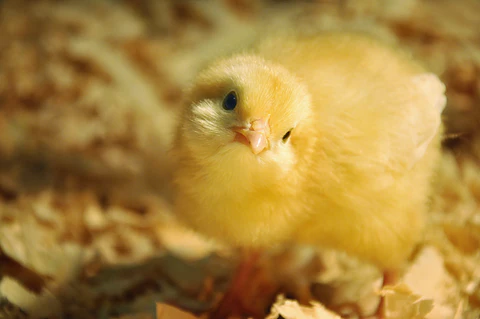 It is natural for chicks to pick or groom themselves. Their new features are full of blood though, so they may bleed after grooming. The red blood spots can attract other chicks to come pick the same spot, endangering the chick. Use a red light in the brooder so that the chicks cannot see blood on each other.
It is natural for chicks to pick or groom themselves. Their new features are full of blood though, so they may bleed after grooming. The red blood spots can attract other chicks to come pick the same spot, endangering the chick. Use a red light in the brooder so that the chicks cannot see blood on each other.
Picking can also be a sign of stress. If you notice your chicks are picking a lot, make sure they have enough space, they are not too hot, they have fresh air, and are not bored. Constant bright light will also cause stress and picking. Using a red light will also help with that issue.
Week 6-9 of Raising Chicks
After six to nine weeks, chicks will not need to have regulated temperature anymore, and you can transition them to the chicken coop. They will start laying eggs around 16-18 weeks.
Congratulations! You just raised your first flock of chicks.
View our product selection to get all of the supplies you need for raising chickens!
Check out Marilyn’s Guide to Raising Chicks
RELATED ARTICLES
Is my Chicken Sick? A Guide To Identifying Illness
Recognizing when your chickens are sick can sometimes be very difficult, primarily because they can hide it very well. As a chicken owner, it is vital to try to recognize early signs before it's too late. You may be wondering how can I tell if my chicken is sick?...
Preparing Your Flock For Winter
As winter approaches, you may wonder what you need to do to prepare your flock for winter and the best ways to care for them. Preparing Your Chicken CoopChicken coops greatly affect how comfortable your chickens are during the winter. There are important steps to take...
Everything You Need To Know About Chicken Combs
What is a Chicken Comb?Chicken combs are the red growths on top of a chicken's head. In rare cases, chicken combs can be black or a shade of purple. They come in a variety of shapes and sizes, but there are nine recognized types: walnut, strawberry, V, rose, single,...

